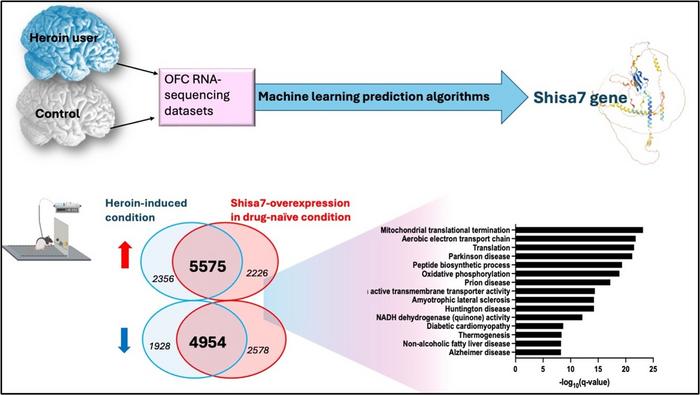Opioid use disorder continues to be a monumental public health crisis, claiming over 350,000 lives each year across the globe. To combat this escalating epidemic, researchers are diving deep into the neurobiological underpinnings of addiction, unearthing unique molecular signatures that may offer a beacon of hope for effective interventions. Recent research led by Dr. Yasmin L. Hurd and her team offers groundbreaking insights into the genetic factors associated with heroin-seeking behavior, situating the gene Shisa7 as a significant player in this complex biological landscape.
The orbitofrontal cortex, a crucial brain region that governs impulse control, decision-making, and emotional responses, serves as a focal point for this research. By leveraging machine learning algorithms, the research team was able to identify distinct molecular signatures prevalent in the brains of human heroin users, which were not merely coincidental, but indicative of underlying biological processes linked to addiction. Such advancements in computational neuroscience pave the way for a more nuanced understanding of the mechanisms fueling opioid addiction.
One of the central findings of the study is the predictive capacity of the Shisa7 gene concerning heroin-seeking behavior. Previously ignored in the context of addiction research, Shisa7 emerged as a potential target for therapeutic interventions. The researchers discovered that modulating the expression of this gene could influence not only the propensity for heroin-seeking behavior but also cognitive flexibility, which is often impaired in substance use disorders. This novel connection opens up new therapeutic avenues that could selectively target the neurobiological basis of addiction.
As the study progressed, the researchers employed preclinical rodent models to validate their findings further. The results were striking; overexpression of Shisa7 in drug-naïve rats resulted in transcriptional changes that mirrored those observed in animals self-administering heroin. This consistency suggests that Shisa7 is intricately linked to the neuroadaptations associated with repeated drug exposure, highlighting its potential as a biomarker for addiction risk and progression.
The researchers utilized advanced machine learning techniques to analyze high-dimensional datasets gleaned from RNA sequencing, allowing them to uncover intricate patterns in gene expression that traditional methods might overlook. The implications of these findings extend beyond addiction treatment—they underscore the potential of artificial intelligence in deciphering the complexities of biological systems. The multidisciplinary approach adopted in this research presents a model for future inquiries into various neuropsychiatric disorders, illuminating pathways that could lead to transformative strategies for intervention.
The relationship between Shisa7 and neurodegenerative processes also raises significant questions regarding the long-term impact of opioid use on brain health. This study underscores the importance of recognizing addiction not merely as a behavioral issue but as a condition with profound neurobiological implications that require a sophisticated understanding of brain chemistry and genetics. The findings suggest that opioid use may contribute to changes that elevate the risk of neurodegenerative diseases, creating a complex interplay between addiction, mental health, and overall neurological health.
In terms of clinical significance, these revelations about Shisa7 could hold the key to developing more effective treatment strategies aimed at preventing relapse in individuals with opioid use disorder. By targeting specific genetic and molecular pathways associated with addiction, it may be possible to cultivate more personalized treatment plans, reducing the reliance on standard pharmacological approaches. Such innovations could mark a paradigm shift in how we approach the treatment of substance use disorders and addiction-related conditions.
Experts in the field, including Dr. John Krystal, Editor of Biological Psychiatry, have noted the critical need for meticulous studies of postmortem brain tissue combined with AI-assisted analyses. Such inquiries are pivotal in identifying molecular targets—like Shisa7—that could facilitate breakthroughs in addiction treatment. The identification of Shisa7 as a target not only sheds light on the biological underpinnings of addiction but also provides a pathway for further research into the mechanisms of decision-making and learning in the context of substance use.
Through the lens of this research, attitudes toward opioid use disorder are beginning to shift. The awareness of the multifaceted nature of addiction is growing, emphasizing the vital role of neuroscience in understanding and addressing the crisis. By situating the findings within a broader context of addiction biology, the study propels discussions on the necessity of interdisciplinary collaboration to tackle the opioid epidemic.
These findings could also have profound implications at the societal level. The intersection of neuroscience and addiction research helps underscore the urgency with which we must address the opioid crisis. The availability of innovative strategies, guided by robust scientific inquiry into the neurobiological components of addiction, could enhance public health responses and inform policy decisions aimed at minimizing the impact of opioid use on communities.
In conclusion, the research exploring the role of Shisa7 in heroin-seeking behavior stands as a testament to how advanced methods in neuroscience can uncover vital links between genetics and addiction. As we delve deeper into the molecular signatures associated with substance use disorders, the potential for new, more effective treatments becomes increasingly tangible. With continued exploration and innovation, the scientific community can remain optimistic about altering the trajectory of the opioid epidemic and improving the lives of those affected by addiction.
Subject of Research: Animals
Article Title: Machine Learning Analysis of the Orbitofrontal Cortex Transcriptome of Human Opioid Users Identifies Shisa7 as a Translational Target Relevant for Heroin Seeking Leveraging a Male Rat Model
News Publication Date: March 26, 2025
Web References: https://doi.org/10.1016/j.biopsych.2024.12.007
References: N/A
Image Credits: Biological Psychiatry/Ellis et al.
Keywords
Opioid use disorder, Shisa7, machine learning, addiction, orbitofrontal cortex, neurobiology, gene expression, neurotransmitters, neurodegenerative disease, personalized treatment, public health, substance use disorders.




